
Detroit has cars. Chicago has slaughterhouses. New Orleans has jazz. We have orange groves.
Had.
For a hundred years, the Bothwell family’s orange grove in Tarzana stood at about a hundred acres. Now only 14 acres remain, the last surviving commercial citrus grove in the San Fernando Valley, and two-thirds of those — let’s call it 10 acres — could soon be plowed under to build 21 high-end houses. They plan to call it “Oakdale Estates.” Not even “Orange Grove Estates” as a memento mori.
By the early 1970s, only 350 acres of commercial orange groves remained in the Valley. Thirty years ago, it had dwindled to about 40 acres. And now 14. My colleague Julia Wick once did the arithmetic and calculated that these 14 acres represent less than one-thousandth of what the Valley possessed at its peak.
Here’s the thing with California’s oranges: The California gold rush, smack in the middle of the 19th century, was an enormous splash in the placer pan. Hundreds of thousands of men inundated the state, and within a fistful of years, they had changed everything — the landscape, the economy, the politics, the fate of Native Americans and of Californios, and of the United States itself. Few of them got rich, but almost nothing thereafter dimmed that lustrous light coming from the Pacific coast.
Then there came the other gold rush — slower, more modest, but with a steady yield that literally could be plucked from trees: the California orange.
Get the latest from Patt Morrison
Los Angeles is a complex place. Luckily, there’s someone who can provide context, history and culture.
You may occasionally receive promotional content from the Los Angeles Times.
The gold in the ground was already beginning to peter out when the orange fruit rose on the Pacific horizon — a gleaming, glowing citrus sun, a stand-in for the sun itself on fruit crate labels, tourist guides, postcards. It was more than food — it was the symbol of the California lush life, a divine talisman of an otherworldly place. And in this oversold earthly Eden, the fruit of pleasure and delight was the orange, not the humdrum apple.
Even into the 1950s, kids living in snowbound American climes might find an orange — one solitary, precious orange — sagging in the toe of their Christmas stocking.
The Southern California writer Carey McWilliams declared, rightly so, that the orange was the true California treasure, “the gold nugget of Southern California.”
The citrus tree and its fruit had become “the living symbol of richness, luxury and elegance … the aristocrat of the orchards.” And a citrus grower was no Midwestern sun-to-sun laboring farmer, but a member of “a unique type of rural-urban aristocracy.”
On a few backyard trees, and in scores of acres of groves, the orange filled the vast valleys of Southern California across a citrus belt that ran for miles. People often quote the acidulous writer H.L. Mencken, who was a dab hand at writing with great verve about how much he hated just about everything.
He visited Los Angeles in 1926 and declared that “the whole place stank of orange blossoms.” But he was being metaphorical, commenting on the swoony gossip of Hollywood stars’ supposed romances: “I heard more sweet love stories in three weeks than I had in New York in thirty years … the whole place stank of orange blossoms.”
Back then, orange blossoms were the de rigueur flower of wedding bouquets.
But Mencken was also literally right. This whole place was as fragrant as a million nuptials. Coming over the Cajon Pass in the right season — and maybe even over the Tejon Pass too — the scent rose up and enveloped you; far into the 20th century, locals and visitors still spoke wistfully of it.
The Valencia orange
And here’s the thing.
Like many of the rest of us, the orange is not a California native.
There are two types of California oranges, and each has its own story.
The Valencia orange came here with the Spanish padres, the seeds planted in the San Gabriel mission garden around 1804. But these transplants were not always the sweet oranges we know, and sometimes their taste had a tinge of the bitter to them, and their rinds could be as tough as the leather vests on the conquering Spanish soldiers, the soldados de cuera.
It was a Yankee fur trader who crossed 3,000 miles of continent to settle here who perfected those mission oranges and made them make money. William Wolfskill was Kentucky-born, and as the snowballing of history and legend goes, he trekked with Daniel Boone, scouted the frontier with the brothers of Kit Carson, and certainly led pack trains on the Santa Fe Trail.
He was a Catholic and became at some point a Mexican citizen, which stood him in good stead, for in California, he was allowed to hunt furs, to hold land, and in time married a daughter of the illustrious Lugo family of Santa Barbara. As “Don Guillermo,” he presided over his properties from the Old Adobe, his homestead near the river.
1
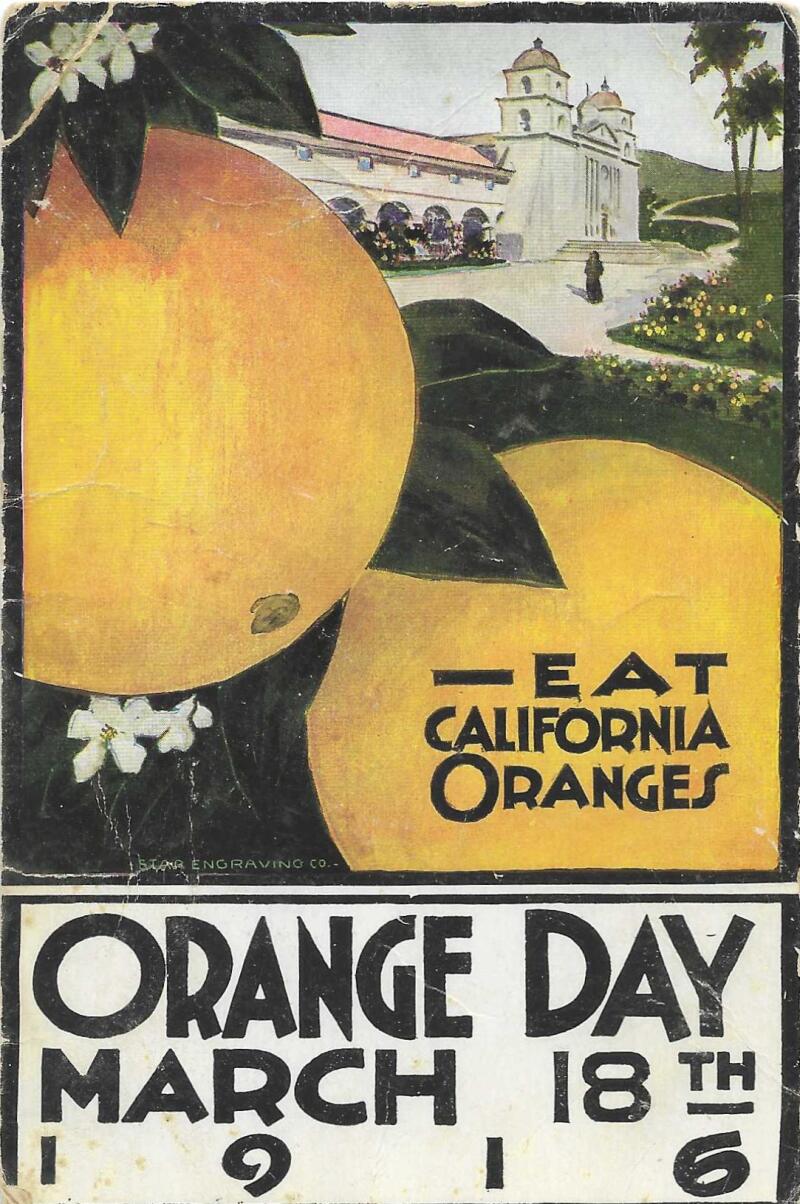
2
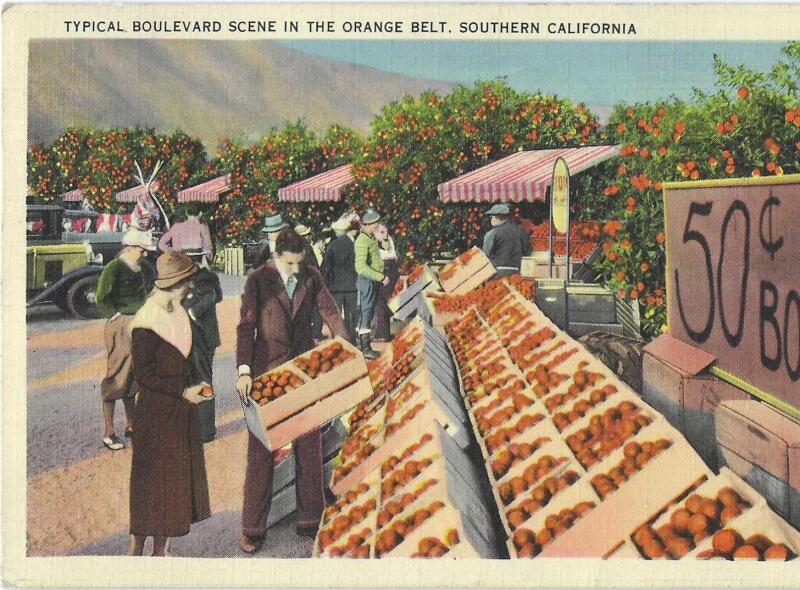
3
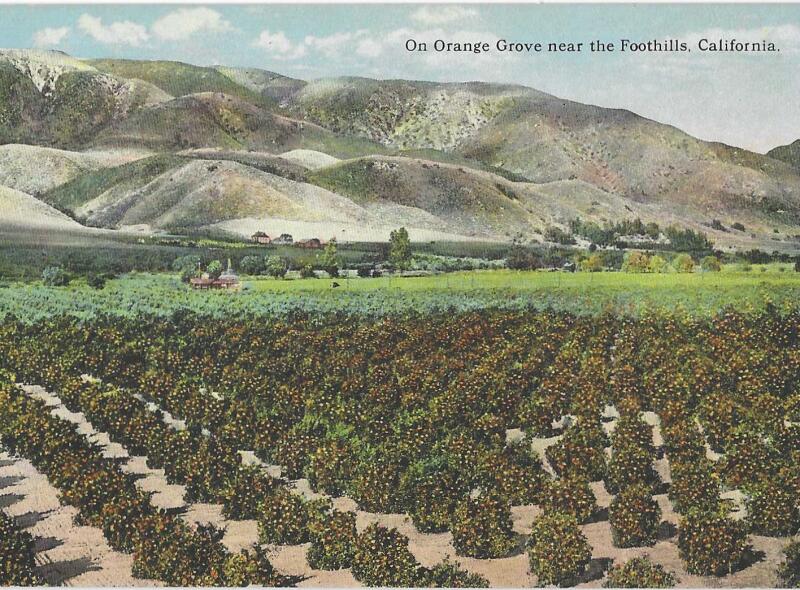
1.An advertisement on a vintage postcard from Patt Morrison’s collection.2.What a steal! A vintage postcard from Patt Morrison’s collection depicts a typical scene, apparently, in the “Orange Belt” of Southern California.3.Orange groves used to dominate thousands of acres of land in Southern California.
But back in 1831, he found himself rather hard up in L.A., and took work as a shipbuilder and trapper. Ten years later he was a man of property.
Like his neighbor, the French winemaker Jean-Louis Vignes, Wolfskill planted vineyards along the Los Angeles River. He also grew pears, figs, quinces, lemons and apples — and oranges. His groves lay from Alameda Street to the river, more or less between 4th and 7th streets, near the present-day Arts District.
Wolfskill’s Valencia orange was coaxed into sweeter, sturdier qualities, and he and his son were soon shipping it eastward, and pdq, Americans cultivated a costly taste for the exotic harvests of faraway California.
But still — it had those annoying seeds.
And soon, it had competition.
The navel orange
Eliza Lovell Tibbets was a woman out of her time. She was a few years younger than Queen Victoria, and looked rather like her, in dress and bearing, and took to accentuating the resemblance.
But in virtually everything else, she was ferociously opposite — unorthodox, even radical. She was a revolutionary in a bombazine dress, a committed abolitionist, a social utopian and tireless suffragist who was divorced not once but twice, at a time when a divorced woman was kept as far from proper society as Pluto is from Earth. In a word, Queen Vick would not have received her.
She was also a spiritualist, like many in her circle, and conducted séances. This she did share with Queen Victoria, who held séances, yearning for a little chat with her beloved ectoplasmic late husband, the sainted Prince Albert.
Not long after the Civil War, Eliza and her third husband, Luther Tibbets, moved to a conquered city in Virginia. Luther too was an energetic abolitionist. By one account, he was run out of Tennessee for trying to stop the lynching of a Black man. As far as some Virginians were concerned, he was also an integrationist carpetbagger. The threatening letters he said he got from the KKK, referring to “shed blood” and “assassination,” he handed over to the American military peacekeepers.
It wouldn’t take much for people like the Tibbetses to decide “the hell with that,” and around 1870, they joined like-minded families and came west, to the place we know as Riverside, founded by the abolitionist John Wesley North.
From here on, the origin mythology of the astounding new orange is as serendipitous and chancy as the odds of human evolution happening again.
1
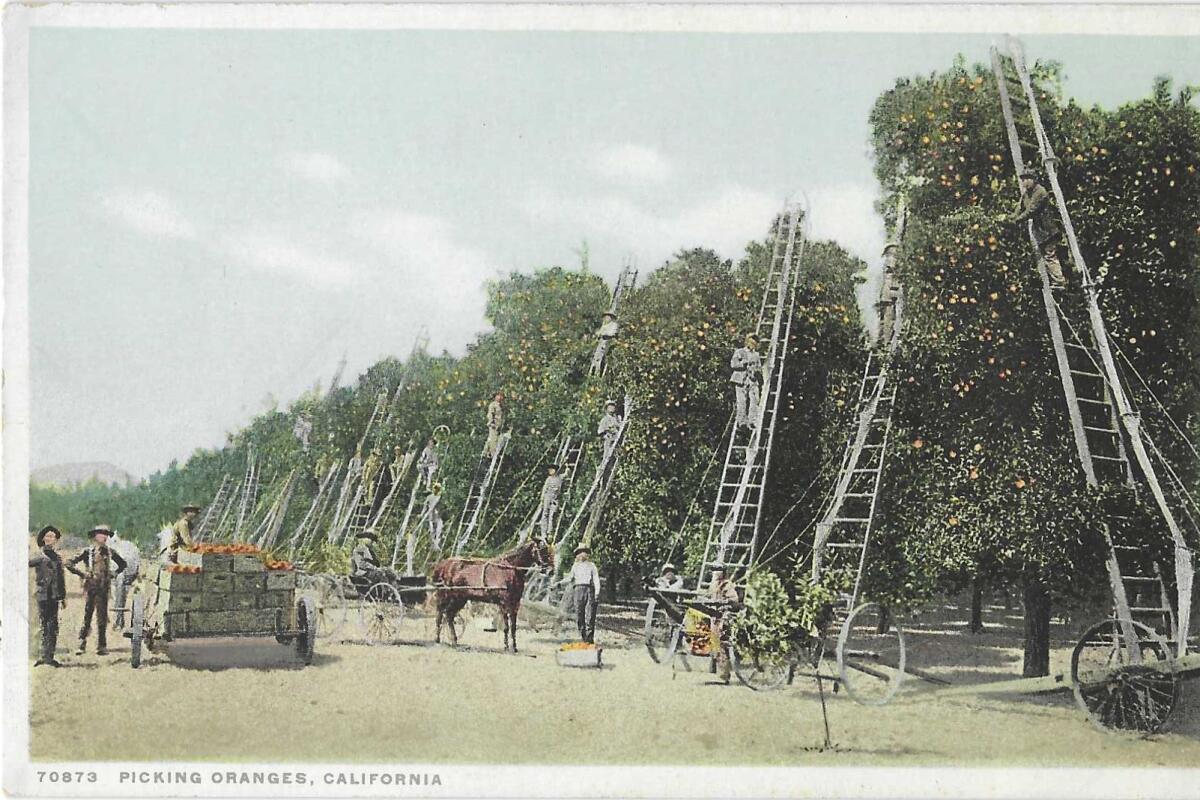
2
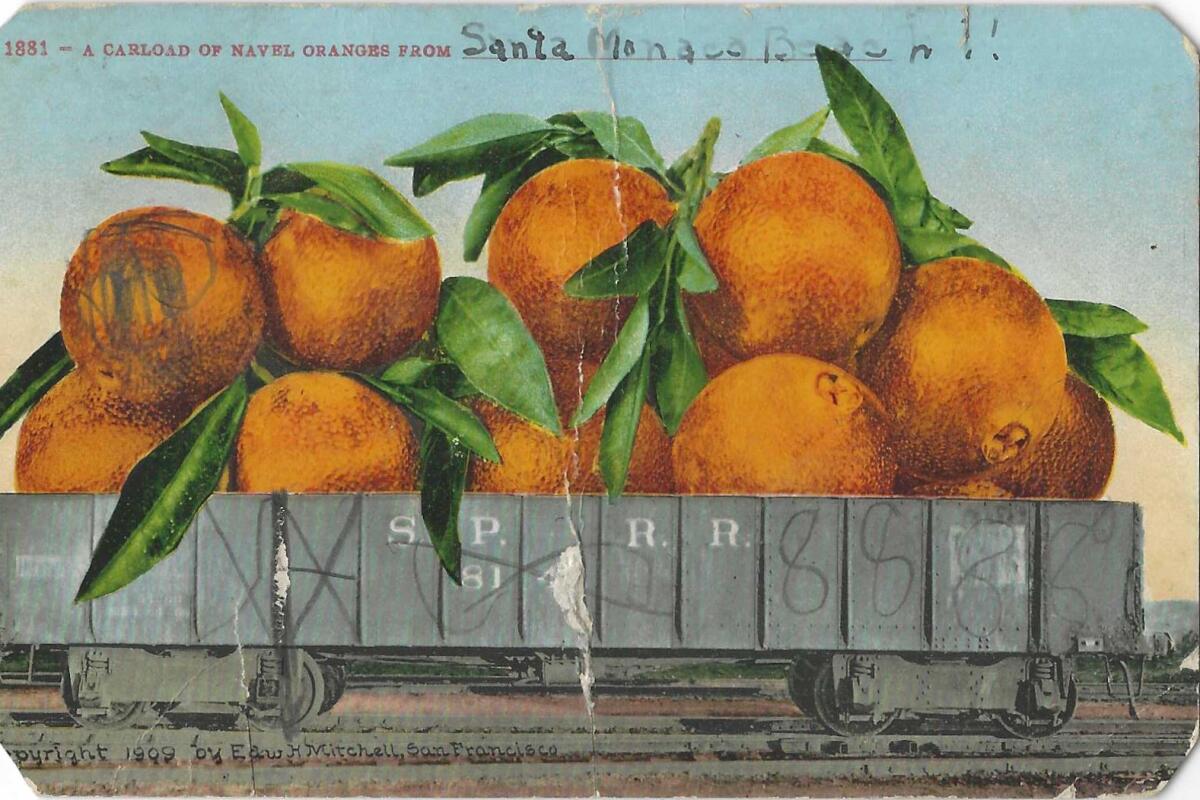
3
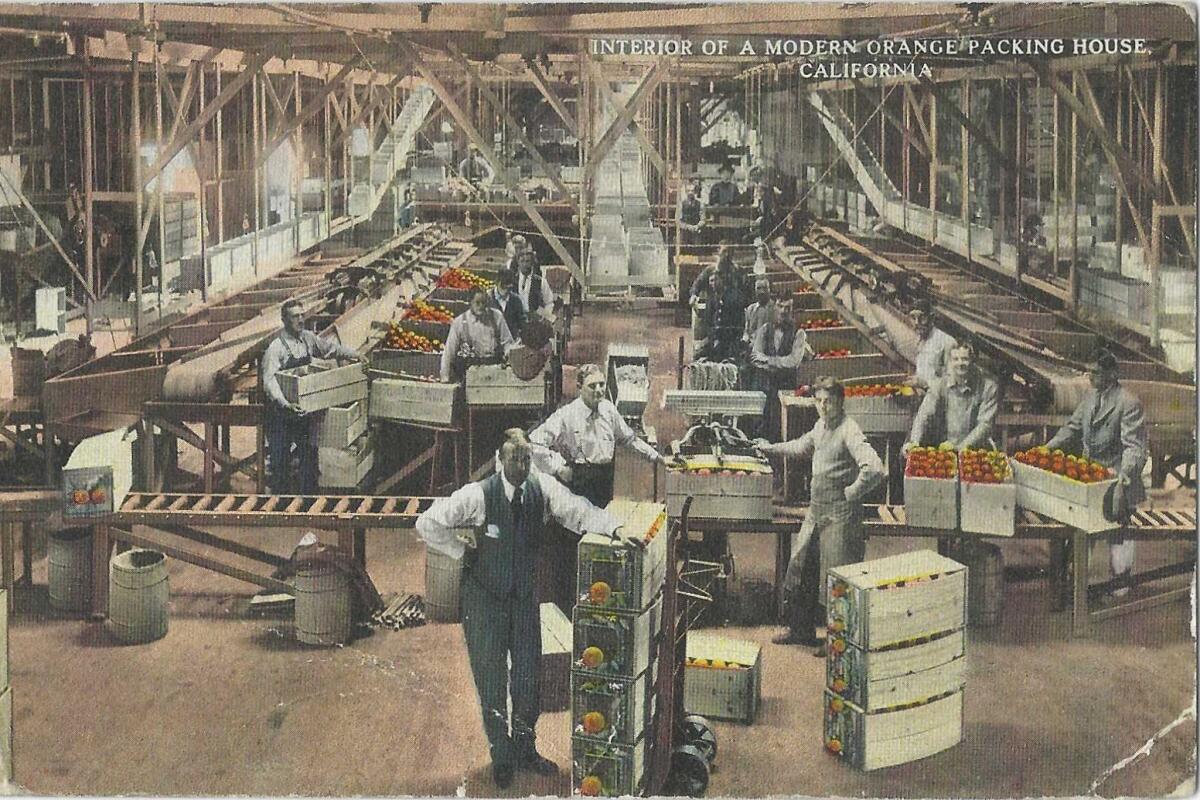
4
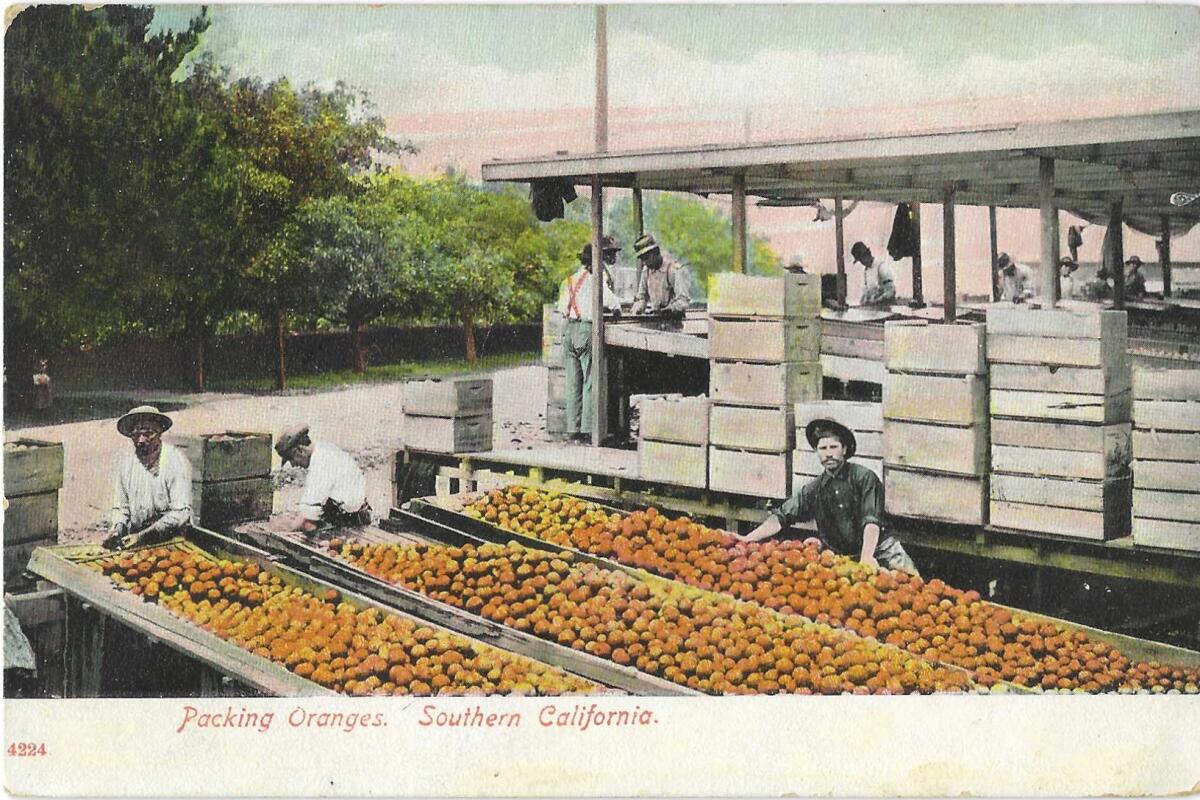
1.Men on tall ladders pick oranges on this vintage postcard from Patt Morrison’s collection.2.A 1924-postmarked postcard exaggerates the size, but not the importance, of California citrus.3.A vintage postcard, bearing a 1920s postmark, shows a “modern orange-packing house.”4.Men pack oranges into crates, depicted on a vintage postcard from Patt Morrison’s collection.
Far off, in the Brazilian Amazon, there grew a seedless orange of fabled sweetness. Travelers marveled at it, and word of it reached the desk of William Saunders, an acquaintance of the Tibbetses and the man in charge of horticultural experiments at the gardens of the newly created U.S. Department of Agriculture.
Saunders had, at President Lincoln’s request, designed the striking layout of Gettysburg national cemetery. Now, in his new post, he thought this orange “might be of value in this country,” he recalled, and wrote back to the correspondent in Brazil (supposedly a “lady missionary,” or perhaps a woman visiting her brother’s rubber plantation), asking for some plants.
A dozen or so arrived at Saunders’ office — at a propitious time, for Luther Tibbets had just written, asking for suggestions for a crop that would grow in Riverside’s climate.
Saunders had ordered the new arrivals grafted onto some trees in the government’s greenhouses, and now he packed off three of the new trees — or was it five, as some accounts say? — to Riverside. Bahia navels, he called them (for the little protrusion at the bottom, which suggests that the orange had an “outie,” not an “innie.”)
And here’s where the legend gets, yes, juicy.
The Tibbetses planted the little trees out in the front of the house — no, others say, it was the backyard. Eliza Tibbets tended them with care, or no, she just nonchalantly watered them with whatever was left sloshing around in her dishpan.
Let’s say there were three trees. One up and died. Another was chewed up, or trampled, or both, by a cow. But whatever Eliza’s husbandry, and however many trees survived, they took several years to bear fruit, and the first crop might have amounted to a massive 16 oranges.
But that was enough.
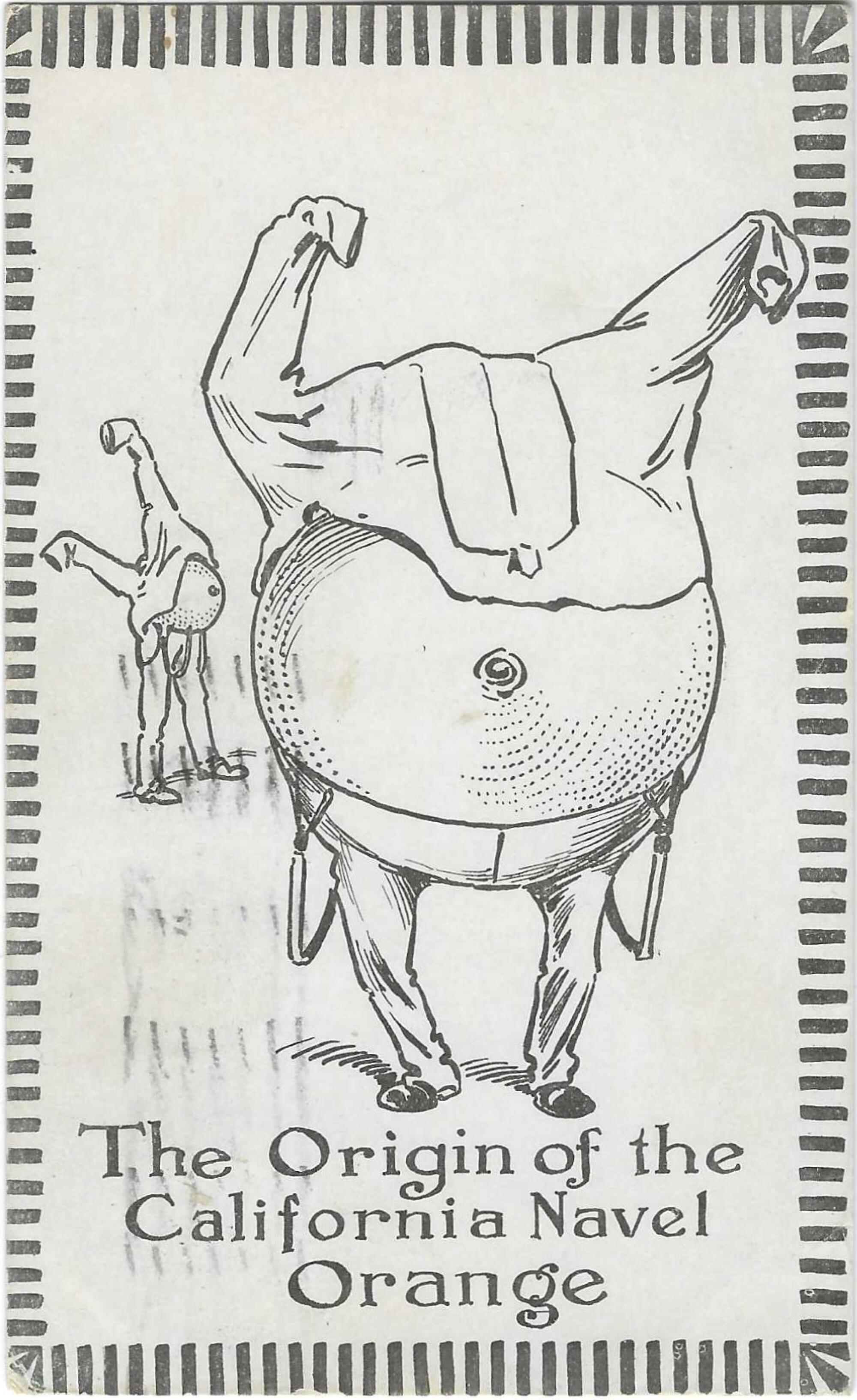
People went crazy for these oranges. Because they’re seedless, you need buds to grow new trees, and soon so many people were trying to steal “just one” from the Tibbetses’ trees that they had to fence off their yard.
The miraculous orange was renamed the Washington navel orange. This was around the time of the nation’s centennial, and the vogue was for everything Washington, though it does sound a little disrespectful to put the godlike name of ”Washington” and a synonym for “belly-button” in the same phrase.
Eliza Tibbets ran a mail-order business for her buds — five cents each. In time they would go for $5 or $10 apiece. (Three of the Tibbetses’ neighbors happened to be horticulturists. They helped to coax the fledgling trees along and took buds themselves, and soon started up prosperous commercial navel orange groves of their own.)
Thus was the massive Southern California industry born. In time, no American breakfast was breakfast without a glass of orange juice. Riverside got rich. Navel orange groves spread for miles. They ornamented their present and gave a glimpse of a grimier future; the smoking smudge pots that burned in the groves on frosty winter nights to keep the trees from freezing created some of L.A.’s earliest smog.
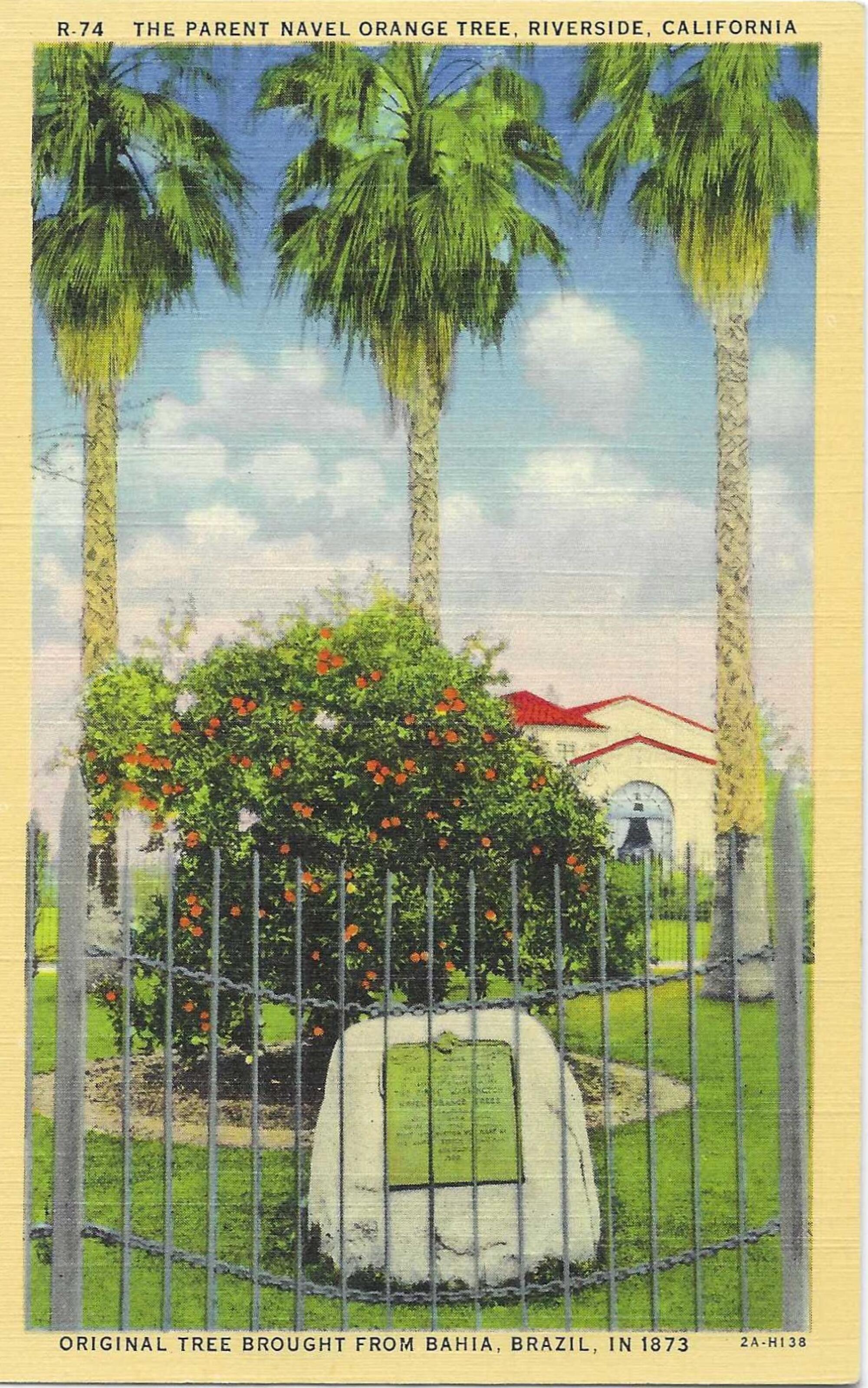
The last surviving Tibbets tree, the “parent tree” of this billion-dollar business, stands in Riverside today, fenced, guarded and commemorated with a plaque noting it as a California historic landmark.
The tree fared better than the Tibbetses themselves. Eliza fled the scorch of Riverside for the Santa Barbara coast, where she died, in 1898. Luther, never the best of businessmen, lost money in typical SoCal fashion — over water rights.
In 1902, as California thought to celebrate the 30th anniversary of the blessing of the navel orange, as 8,000 railroad cars of oranges were sent to market each year, Luther Tibbets was living in a Riverside poorhouse. His house had been foreclosed on, and he was himself, as the New York Times described him, a “white-haired, tattered public charge.” He died a few months later.
Let’s accelerate to today, to the Tarzana grove. A 2022 deal announced by Councilmember Bob Blumenfield would preserve one-third of the Bothwell property under the aegis of the Mountains Preservation and Conservation Authority. A double lane of citrus trees would march along Oakdale Avenue’s west side.
As of a couple of years ago, in Anaheim — itself a regular money machine of citrus prosperity — two acres only remained of the Pressel family orchards, a place of historic import for the history of citrus and of labor. This survivor, too, was meant to serve as an open-air “tree museum.” In their heads, visitors could try to multiply this meager urban plot times more than 30,000, projecting onto the stucco-to-stucco landscape all of the acres of citrus trees that once spread their branches across Orange County.
In June of 1932, California declared the last surviving Tibbets orange tree to be a state historical landmark. The following year, the Depression-era screwball comedy “Bombshell” was released. Its blonde star, Jean Harlow, is playing a blonde star, Lola Burns, and in one scene, her butler hands her a glass of juice and she takes a sip.
Burns: “Hey! This isn’t orange juice.”
Butler: “No, miss, it’s … it’s sauerkraut juice.”
Burns: “Well, take it away. It’s like dipping your tongue in lox.”
Butler: “But, I’m sorry, miss, but there weren’t any oranges.”
Burns: “No oranges? This is California, man!”
Explaining L.A. With Patt Morrison
Los Angeles is a complex place. In this weekly feature, Patt Morrison is explaining how it works, its history and its culture.
